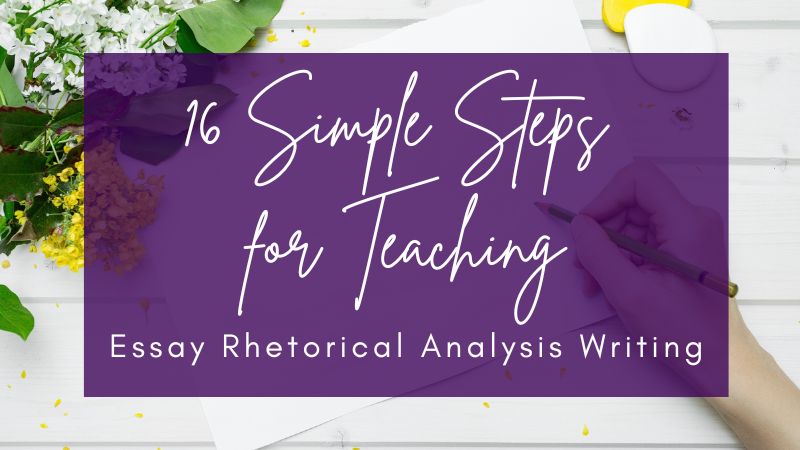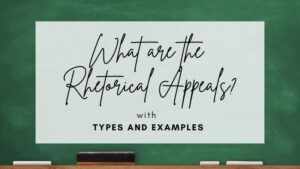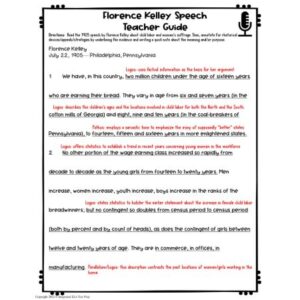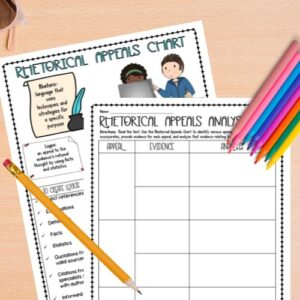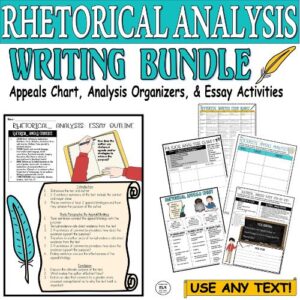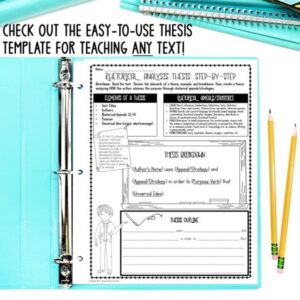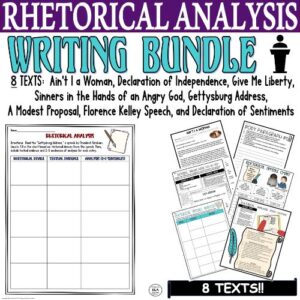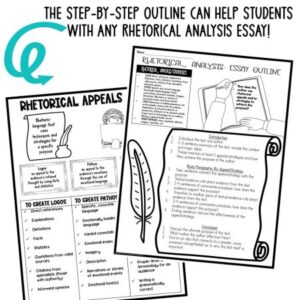Very often, we sit and stare at the pacing guide for rhetorical analysis essay writing with a deer-in-the-headlights look. How do we go about teaching essay rhetorical analysis writing when our students struggle with writing a basic 3-5 paragraph expository or argumentative essay and cannot read on grade level?
I totally get it! For 5 years, I taught AP English Language and Composition as well as Dual Enrollment classes for 11th/12th grade ELA, and only about half of my students had passed the 10th-grade reading state standardized test. And essay rhetorical analysis writing is a VITAL skill to student success in Advanced Placement and/or Dual Enrollment courses.
For these students, the trek to mastering this type of analytical writing is very difficult; however, trying to teach the average or below-average reading and/or writing student can be even more challenging. But don’t lose hope!
I hope you keep reading below to get help with the essay rhetorical analysis writing process!
By following these 16 Super Simple Steps for Teaching Essay Rhetorical Analysis Writing, you and your students will have a much easier time meeting these academic milestones!
Need help with Test Prep? Check out this FREE Pack of 3 Test Prep Activities to help students achieve success on standardized tests!
What is Rhetorical Analysis?
Often, students have never heard terms like rhetoric or rhetorical analysis before, especially in standard middle school or early high school classrooms.
So we need to start with basic definitions when beginning our examination of essay rhetorical analysis writing!
Rhetoric is the language used to achieve a specific purpose. It sounds fancy, but really, this definition personifies what rhetoric is!
Rhetorical Analysis requires the reader to examine the strategies used by the rhetor, analyze how they are being utilized, and assess their overall effectiveness in achieving the purpose. It can vary greatly depending on the situation, the rhetor (speaker/writer/creator), the overall purpose or intention, the audience, etc.
By first explaining some of these ideas, you will be setting the groundwork for starting your rhetorical analysis unit!

16 Simple Steps for Teaching Essay Rhetorical Analysis Writing
1. Introduce the definition of rhetoric analysis and explain its importance.
Rhetorical Analysis requires the reader to examine the strategies used by the rhetor, analyze how they are being utilized, and assess their overall effectiveness in achieving the purpose. It can vary greatly depending on the situation, the rhetor (speaker/writer/creator), the overall purpose or intention, the audience, etc.
Explain to your students that we use rhetoric every day, and you can ask your students a simple question: What would you say to your parents if you arrive home one hour past curfew?
This question seems simple, but there are so many possible answers and effective ways of responding to this question in the hopes that the consequences are nonexistent or benign at worst. If you use one type of rhetoric, you might end up with a month of grounding. But if you use other types of rhetoric, you might achieve your goal of avoiding punishment…
Another easy way to begin this discussion is by watching ads. Students don’t have to examine logical fallacies or persuasive techniques right away. Instead, just take the time to examine advertisements and what makes them effective.
Ask students to identify the following:
- Rhetor-who created the ad?
- Audience-who is this ad geared toward?
- Rhetoric-what language is used throughout?
- Purpose-what purpose(s) does the creator/rhetor hope to achieve?
Ultimately, we want students to examine the effectiveness of the rhetoric within a text like an advertisement. What makes it effective?
By starting off in this way, your students will start to see the importance of analyzing the rhetoric they encounter every day.
2. Explain the various types of rhetorical appeals and strategies.
START WITH RHETORICAL APPEALS
Any unit or lesson focused on rhetoric usually first introduces the appeals – ethos, logos, and pathos.
- Ethos is the appeal to the audience through a belief in the writer’s authority or credibility.
- Logos is the appeal to the audience’s rational thoughts using facts and statistics.
- Pathos is the appeal to the audience’s emotions through emotional language.
Check out What are the Rhetorical Appeals? 3 Important Appeals! for specific details about each appeal!
MOVE ON TO OTHER RHETORICAL STRATEGIES
- Repetition-Using the same word or phrase more than once, particularly in close proximity usually has significance.
- Alliteration-Much like the repetition of a word or phrase, the repetition of a beginning letter sound in close proximity – aka alliteration – draws the audience’s attention.
- Hyperbole-This device refers to the use of extreme exaggeration.
- Irony-When a writer includes deliberately contrary information to elicit a particular effect, we know this as irony.
- Allusion-A writer who alludes to other texts with mythical, literary, biblical, religious, pop culture, and historical elements often does this to connect to other big ideas.
- Tone-Tone is the writer’s emotion about a topic.
- Imagery-Description tied to the five senses refers to imagery.
- Rhetorical Question-Does this one need an explanation? Voila, a rhetorical question! It implies an answer but doesn’t require one.
- Point of View-The writer decides who tells the ‘story’ and who the audience is, too.
- Comparison: Simile and Metaphor-The comparisons an author includes through simile and metaphor are used to simplify a complex text. A simile is a comparison of unlike things using like or as. A metaphor is a comparison of unlike things without using like or as.
Want an easy-to-use RHETORICAL APPEALS CHART? Click HERE!
3. Start out with short speeches, video clips, and movie scenes with interesting rhetoric.
You don’t have to break down older, classical rhetoric right away. Delving into seminal pieces of traditional texts can be quite overwhelming for most people, let alone high school students.
So start off with shorter, less complex pieces of rhetoric:
- Speeches less than 1 page like The Gettysburg Address or Ain’t I a Woman?
- TED Talks™
- Narratives
- Podcasts
- Movie Clips (one of my favorites is the last speech from Mr. Smith Goes to Washington)
- YouTube™ Videos
4. Annotate for effective strategies/appeals with your students.
There is no substitute for modeling what good annotations look like. Taking your students through the process is super helpful. Plus, when students practice over and over again before their essay rhetorical analysis assessments, annotating will become natural to them!
Highlight and Annotate EVIDENCE for the following elements to help prepare for their essay rhetorical analysis assignments:
-Rhetor
-Audience
-Context/Situation
-Purpose
-Rhetorical Appeals
-Other Rhetorical Strategies
-Tone
Click below to get a teacher example for Florence Kelley’s Speech!
5. Use graphic organizers to examine the rhetorical situation and strategies.
Ultimately, we need to help students to organize their thoughts! And using graphic organizers that lead to writing the actual essay is the goal!
- Speaker-Make sure to have students provide the name and describe the speaker (physical or mental characteristics). Using evidence from the directions or text is key.
- Purpose-Usually the purpose is near the end of the first paragraph of the text. When it comes to satire, the real purpose is often near the end of the text. Think: What does the speaker really hope to accomplish?
- Audience-The “reader” is ALMOST NEVER the answer. Sojourner Truth’s intended audience is not ME; she is speaking to a crowd back in the 1800s. A simple description of the goal audience should be inferred or directly stated within the rhetoric.
- Universal Idea-Typically, the rhetoric surrounds a main topic, idea, or message. This universal idea should be directly connected to the purpose.
- Tone-What is the tone/emotion of the speaker towards the topic/idea? What diction is used to get this tone across?
- Strategies-You can identify appeals, strategies, techniques, devices, etc. Really, they are the same things. They are tools to achieve the speaker’s goals!
After students identify the above information with textual evidence to accompany each concept, let students take the time to discuss how the evidence reveals the purpose!
Here is an example from the Declaration of Independence:
| Ex. “He has plundered our seas, ravaged our Coasts, burnt our towns, and destroyed the lives of our people.” | Ex. This description reveals the horrible acts of the English against the colonists with an emphasis on the all-consuming destruction the colonists have faced. By using this depiction, Jefferson seeks to elicit sympathy for the colonists’ right to declare independence in light of what they have suffered. |
6. Demonstrate how to use graphic organizers to prepare for an essay rhetorical analysis writing prompt.
When the graphic organizers for SPAUTS and the Rhetorical Analysis of EACH piece of evidence have been filled out, the student is ready for the essay rhetorical analysis writing process. If students have this information, the actual writing of the essay is EASY!
Without the speaker, purpose, audience, universal ideas, tone, and strategies as well as the analysis, the essay rhetorical analysis writing experience will be overwhelming!
You can combat some of the overwhelm by offering examples!
If you show students rhetorical analysis essay examples, they will be able to easily see each element in the essays. Perhaps, you could reverse the process and have students fill out the organizers based on the information in the student examples!
Click below for pre-writing essay rhetorical analysis organizers!
7. Practice writing thesis statements based on the text and organizer.
Students need a starting place, especially in the thesis writing process. When they master the basics, they can start experimenting with other structures!
Here is my basic template:
Your template could look like the following: In ________________________(text), ________________(author) uses ______________, _______________, and _______________ in order to _________ (purpose verb) ________(audience) to ________________________________________________(universal idea).
Feel free to vary this template based on the text and/or your students’ needs!
8. Show students how to start an essay rhetorical analysis introductory paragraph.
Remember, the purpose of a rhetorical analysis is NOT the act of creating rhetoric but of examining how a rhetor achieves his or her purpose. Well, this is not entirely true. Once in a while, an accomplished writer can be successful in both; however, let’s start with the basics, shall we?
- Introduce the text title, rhetor, audience, and overall context (when it was written, place, etc.).
- Summarize the text in 2-3 sentences. There is no need to go into too many details or include random quotes, questions, or fancy techniques.
- Write the thesis near the end in 1 or 2 sentences. Some teachers can be super hardcore about a 1-sentence thesis, but I find that some students do better with flexible options.
After they write 3 or 4 introductions, they will be much more confident when they start writing the “dreaded” body paragraphs.
9. Model how to write a body paragraph based on the graphic organizer, thesis, and essay outline.
Body Paragraphs: By Appeal/Strategy
1. Topic sentence-connect the appeal/strategy with the purpose (use the thesis for help)
2. Textual evidence-cite direct evidence from the text (use evidence from the organizers)
3. 2-4 sentences of commentary/analysis; how does the evidence support the purpose? (use the rhetorical analysis for the evidence)
4. Transition to another piece of textual evidence-cite direct evidence from the text (use evidence from the organizers)
5. 2-4 sentences of commentary/analysis; how does the evidence support the purpose? (use the rhetorical analysis for the evidence)
6. Ending sentence-discuss the effectiveness of the appeal/strategy (use the thesis for help)
10. Let students practice writing their body paragraphs based on previously analyzed texts first.
Students don’t need to go into writing their first essay rhetorical analysis assignments without some practice with familiar passages first. In order to write moderately well and effectively, try using previous texts with organizers, thesis statements, and introductory paragraphs.
Trust me; students will heave a huge sigh of relief if you offer this opportunity!
Click 5 Elements of an Effective Outline for Rhetorical Analysis Essay Writing for additional help with essay rhetorical analysis writing!
11. Provide easy-to-use rubrics and read through them in your class.
There are so many rubrics out there, but I actually like more specific, objective rubrics rather than subjective rubrics.
Ex. Support-When I ask for evidence, I want to see at least 4-6 pieces of evidence for a 4-paragraph essay.
Ex. Grammar-I usually include numbers here, so students can identify specific issues.
Reading over the rubrics before writing the essay rhetorical analysis task, during the writing process, and after the essay has been written will help many students meet their goals!
12. Give students easier texts to analyze for their full first essay rhetorical analysis writing prompt.
I would definitely start with easier passages of rhetoric before assigning classic nonfiction or satire. Sojourner Truth’s “Ain’t I a Woman” or Florence Kelley’s Speech about Child Labor should be MUCH easier to analyze versus “Give Me Liberty,” the Declaration of Independence, or “A Modest Proposal.”
In fact, I would not approach these super high-level texts until at least 10th-grade English.
TOP TIP: Let students work in PAIRS to write their first fully-developed essay. Think of it as additional, most likely needed, practice for future essay rhetorical analysis assignments 🙂
13. Guide your class through their first essay rhetorical analysis drafts by having them highlight the thesis, topic sentences, evidence, and analysis.
After students have written a 4+ paragraph rhetorical analysis essay, take the time to do a writing conference.
Highlight/Underline the following in different colors:
- Thesis, Topic Sentences, & Ending Sentences-They should all be connected through the strategy and purpose.
- Evidence-Students need to have evidence in every body paragraph. I prefer at least 2 pieces of textual evidence for each body paragraph.
- Analysis-The goal is to see if the student is summarizing or analyzing how the evidence contributes to the overall purpose. I like to see 2+ sentences after each piece of evidence for their rhetorical analyses.
- Transitions-I definitely want to see embedded transitions (He also includes…/She additionally utilizes…) versus “Firstly,” “Next,” and “In Conclusion.”
- Higher-Level Language-If students use repetitive, general terms versus specific, varied vocabulary, they will see how they can improve.
- Complex and Simple Sentences-I don’t really care if they have super-long or super-short sentences as long as they are grammatically correct. Taking the time to change up the sentence structure is key!
When students see what they are accomplishing and how they can improve, they will make progress. Additionally, let other students who have good analysis, share it out. When students hear what others are saying in their writing, they can begin to see what your expectations are!
Check out the pack below to get a step-by-step rhetorical analysis writing pack for ANY text!
14. Offer the opportunity to revise and resubmit their essay rhetorical analysis drafts.
If you are worried about AI issues, I totally get it. In this day and age, you may want to keep student writing in class only.
And if students want this opportunity to revise and resubmit their essay rhetorical analysis drafts, then you could provide time in class to accomplish this goal.
As soon as students take the draft home, there exists the possibility of cheating. Whatever works for your classroom, do it!
15. Supply at least 2 essay rhetorical analysis writing assignments for practice.
I am clearly a big fan of practice makes better. Perfection is unobtainable, but better is always possible, especially when it comes to essay rhetorical analysis writing!
If you are in the middle of teaching a Women in Literature unit, you could have students start out by examining “Ain’t I a Woman,” move on to the Florence Kelley Speech, and end with the “Declaration of Sentiments!”
These speeches are not super long, but they are long enough to have plenty of material to write about. Plus, this scaffolding of textual complexity will help your students level up their essay rhetorical analysis skills!
Check out this Essay Rhetorical Analysis Writing Bundle to help you teach 8 pieces of classic rhetoric!
16. Encourage students to bring in their own rhetoric for a rhetorical analysis project/presentation.
To extend this unit on essay rhetorical analysis concepts, you could have your students bring in their own pieces of rhetoric!
Students could offer up songs, poetry, advertisements, video clips, movie scenes, podcast episode transcripts, art, etc.
In class, you could do an analysis as a whole group, let students work in small groups, or trade to examine the rhetoric independently. After discussing the major elements of each, your students could mirror the genre and create their own rhetoric!
Not every essay rhetorical analysis has to end in a writing assignment; you could give lots of options to choose from!
Need more fun lessons and activities for essay rhetorical analysis concepts? Check out my store Kristin Menke-Integrated ELA Test Prep!

